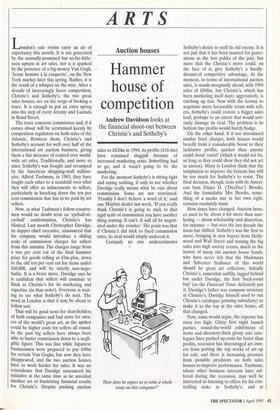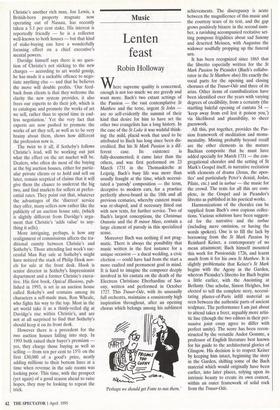ARTS
Auction houses
Hammer house of competition
Andrew Davidson looks at the financial shoot-out between Christie's and Sotheby's London's sale rooms carry an air of expectancy this month. It is not generated by the annually-promised but so-far-little- seen upturn in art sales, nor is it sparked by the presence of a big-money Van Gogh, `Jeune homme a la casquette', on the New York market later this spring. Rather, it is the result of a whisper on the wire. After a decade of increasingly fierce competition, Christie's and Sotheby's, the two great sales houses, are on the verge of broking a truce. It is enough to put an extra spring into the step of every Jeremy and Lucinda in Bond Street.
The truce concerns commission and, if it comes about will be scrutinised keenly by competition regulators on both sides of the Atlantic. Between them, Christie's and Sotheby's account for well over half of the international art auction business, giving them a fair measure of control over world- wide art sales. Traditionally, and more so since Sotheby's was bought and revamped by the American shopping-mall million- aire, Alfred Taubman, in 1983, they have fought each other to a standstill over what they will offer as inducements to sellers, particularly in knocking down the ten per cent commission that has to be paid by art sellers.
Now, in what Taubman's fellow-country- men would no doubt term an 'eyeball-to- eyeball' confrontation, Christie's has blinked. Last month Christopher Davidge, its dapper chief executive, announced that his company would introduce a sliding scale of commission charges for sellers from this autumn. The charges range from a two per cent cut of the final hammer price for goods selling at £3m-plus, down to the old ten per cent cut for items undei £60,000, and will be strictly non-nego- tiable. It is a brave move. Davidge says he is confident that sellers will continue to flock to Christie's for its marketing and expertise (in that order). Everyone is wait- ing to see what Sotheby's do next. The word in London is that it may be about to follow suit.
That will be good news for shareholders of both companies and bad news for own- ers of the world's great art, as the upshot could be higher costs for sellers all round. In the past big sellers have always been able to barter commission down to a negli- gible figure. This was fine while Japanese businessmen were prepared to pay £40m for certain Van Goghs, but now they have disappeared, and the two auction houses have to work harder for sales. It was no coincidence that Davidge announced his initiative at the same time as he unveiled another set of frustrating financial results for Christie's. Despite pushing auction sales to £820m in 1994, its profits (E16.4m) have remained sluggish because of increased marketing costs. Something had to go, and it wasn't going to be the marketing.
For the moment Sotheby's is sitting tight and saying nothing, if only to see whether Davidge really means what he says about commission. Some are not convinced. `Frankly I don't believe a word of it,' said one Mayfair dealer last week, 'If you really think Christie's is going to stick to that rigid scale of commission you have another thing coming. It can't. It will all be negoti- ated under the counter.' His point was that if Christie's did stick to fixed commission rates, its rival would simply undercut it.
Certainly no one underestimates `How does he expect us to write a whole essay on this computer?' Sotheby's desire to stuff its old enemy. It is not just that it has been taunted for gener- ations as the less pukka of the pair, but more that the Christie's move could, on the face of it, give Sotheby's a hardly- dreamt-of competitive advantage. At the moment, in terms of international auction sales, it stands marginally ahead, with 1994 sales of £868m, but Christie's, which has been marketing itself more aggressively, is catching up fast. Now with the leeway to negotiate more favourable terms with sell- ers, Sotheby's could restore a bigger sales lead, perhaps to an extent that would seri- ously damage its rival. The problem is its bottom line profits would barely budge.
On the other hand, if it too introduced similar fixed charges, both houses would benefit from a considerable boost to their lacklustre profits, quicker than anyone could shout 'cartel' (which it would not be, so long as they could show they did not act in unison). Many in London think that the temptation to improve the bottom line will be too much for Sotheby's to resist. The final decision, though, rests with its Ameri- can boss Diana D. (DeeDee') Brooks. And the formidable Mrs Brooks, some- thing of a media star in her own right, remains resolutely mum.
How times have changed. Auction hous- es used to be about a lot more than mar- keting — about scholarship and discretion, for instance — but over the last decade the focus has shifted. Sotheby's was the first to move, bringing in new buyers from Holly- wood and Wall Street and turning the big sales into high society events, much to the horror of many old auction house hands, who have never felt that the Madonnas and Sylvester Stallones of this world should be great art collectors. Initially Christie's, somewhat sniffily, lagged behind but under Davidge, the first tack-room boy' (as the Financial Times delicately put it; Davidge's father was company secretary at Christie's, Davidge himself used to run Christie's catalogue printing subsidiary) to make it to the top at the sales house, all that changed.
Now, some would argue, the expense has risen too high. Glitzy first night launch parties, round-the-world exhibitions of items and directory-thick glossy sale cata- logues have pushed up costs far faster than profits, recession has discouraged art own- ers from putting the top works of art up for sale, and there is increasing pressure from possible predators on both sales houses to improve performance. Taubman, whose other business interests have suf- fered during the recession, may well be interested in listening to offers for his con- trolling stake in Sotheby's, and at Christie's another rich man, Joe Lewis, a British-born property magnate now operating out of Nassau, has recently taken a 5.1 per cent stake. His interest is reportedly friendly — he is a collector well-known to both houses — but that kind of stake-buying can have a wonderfully focusing effect on a chief executive's mental powers.
Davidge himself says there is no ques- tion of Christie's not sticking to the new charges — according to art world gossip, he has made it a sackable offence to nego- tiate anything else — and that he believes the move will double profits. 'Our feed- back from clients is that they welcome the clarity the new system provides, it also frees our experts to do their job, which is to catalogue and promote the works of art we sell, rather than to spend time in end- less negotiation.' Yet the very fact that experts are now pushed to promote the works of art they sell, as well as to be very brainy about them, shows how different the profession now is.
The twist to it all, if Sotheby's follows Christie's lead, will be working out just what the effect on the art market will be. Dealers, who often do most of the buying at the big auction houses, either for partic- ular private clients or to hold and sell on later, remain sceptical of claims that it will give them the chance to undercut the big two, and find markets for sellers at prefer- ential rates. They point out that, whatever the advantages of the 'discreet' service they offer, many sellers now rather like the publicity of an auction house sale, (which is slightly different from Davidge's argu- ment that Christie's 'adds value' to any- thing it sells).
More intriguing, perhaps, is how any realignment of commissions affects the tra- ditional enmity between Christie's and Sotheby's. Those attending last week's suc- cessful Man Ray sale at Sotheby's might have noticed the stack of Philip Hook nov- els for sale at the front desk. Hook is senior director in Sotheby's Impressionist department and a former Christie's execu- tive. His first book, Optical Illusions, pub- lished in 1993, is set in an auction house called Rokeby's and contains among its characters a self-made man, Ron Wheale, who fights his way to the top. Most in the art world take it as a thinly-veiled dig at Davidge's rise within Christie's, and are not at all surprised to find that Sotheby's should keep it on its front desk.
However there is a precedent for the two auction houses falling into step. In 1993 both raised their buyer's premium - yes, they charge those buying as well as selling — from ten per cent to 15% on the first £30,000 of a good's price, neatly adding millions to their bottom lines at a time when revenue in the sale rooms was looking poor. This time, with the prospect (yet again) of a good season ahead to raise hopes, they may be looking to repeat the trick.



























































 Previous page
Previous page